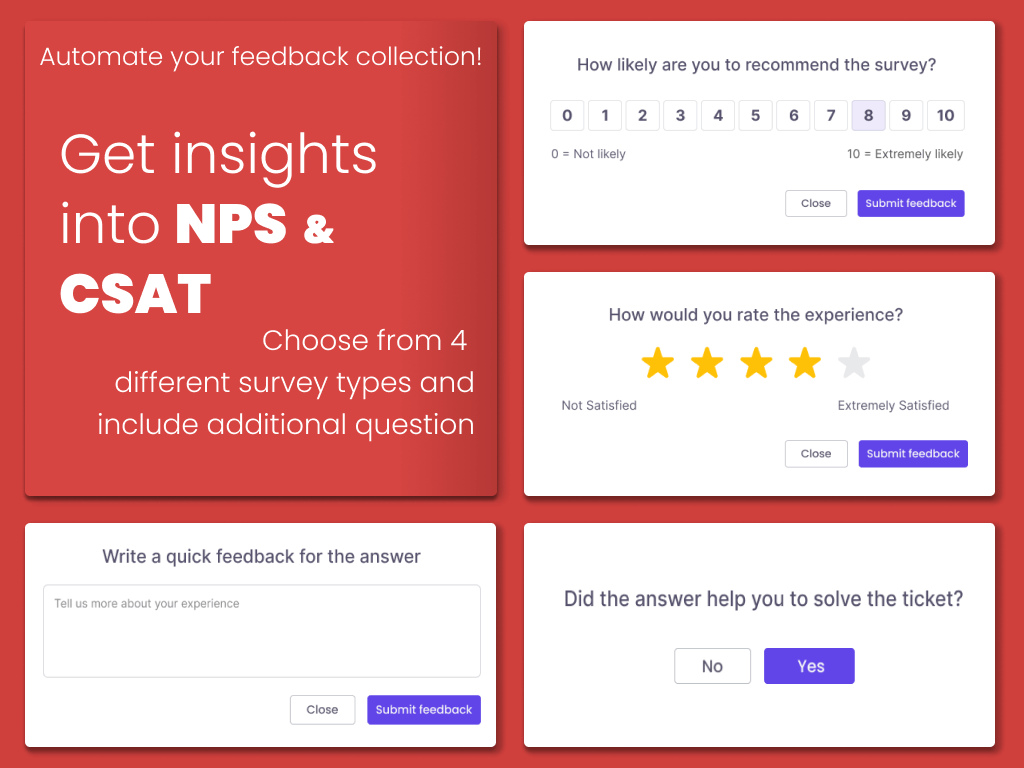You can spend a fortune on advertising, but nothing beats the organic growth driven by word of mouth. So, how do you bottle that lightning? How do you quantify loyalty? The answer lies in one simple, yet profoundly effective metric derived from the single most critical feedback tool: the Net Promoter Score question.
This metric, known as the Net Promoter Score (NPS), has become the industry standard for measuring customer loyalty and devotion. It cuts through the noise of fleeting satisfaction surveys and gets straight to the core of your company’s growth potential. To achieve a genuine measure of customer advocacy and a clear path to operational improvements, it is essential to understand what NPS stands for. We're going to dive deep into this simple scale and show you how to leverage the resulting NPS score question to transform your business.
What is an NPS?
The Net Promoter Score (NPS) is a key performance indicator (KPI) that measures customers' loyalty to a company. It wasn’t invented by a committee of survey experts; rather, it was conceived by Fred Reichheld, Bain & Company, and Satmetrix in 2003 as an answer to an increasingly complex customer feedback landscape. They sought a single, robust question that strongly correlated with repurchase rates and referrals, the fundamental drivers of sustainable business growth.
The resulting Net Promoter Score question is deceptively simple:
"On a scale of 0 to 10, how likely are you to recommend [Company Name] to a friend or colleague?"
This single question is the engine behind the entire metric. It doesn't just ask about satisfaction; it asks customers to put their own reputation on the line. That commitment is a far stronger indicator of true loyalty and future behavior than mere transactional contentment. The resulting NPS score question provides a direct gauge of your organization’s ability to create evangelists, a critical component of effective marketing.
How to calculate Net Promoter Score?
Calculating your Net Promoter Score is refreshingly simple, but it requires that you first correctly segment your customer responses based on the numerical rating they provide. You group customers into one of three distinct categories: Promoters, Passives, or Detractors, based on the NPS scoring scale.

How the NPS scoring scale works
The scale runs from 0 (Not at all likely) to 10 (Extremely likely). Your customers’ answers slot them into one of these three action-oriented buckets:
- Promoters (Score 9-10): These are your enthusiastic advocates. Promoters are fiercely loyal customers who are highly likely to recommend you. They are the engine of your organic growth, often forgiving of small mistakes, and they contribute significantly to positive word-of-mouth marketing. They exhibit strong nps customer satisfaction and are essential to scaling.
- Passives (Score 7-8): Passives are satisfied, but unenthusiastic. They are largely neutral and, to use a rather awkward phrase, stand on the sidelines when it comes to advocacy. They are content with your product but not loyal. They are vulnerable to competitive offerings and, crucially, are not included in the NPS calculation itself. They represent a significant opportunity for improvement.
- Detractors (Score 0-6): Detractors are unhappy customers. They are highly unlikely to recommend your company and, worse, are very likely to generate negative word-of-mouth. They are the customers who will openly complain on social media or in person. They are, in a somewhat awkward phrase, the millstone around your business’s neck. Addressing Detractor feedback is essential for minimizing reputational risk and churn.
Different Formulas for Calculating the Net Promoter Score (NPS)
While the standard definition, NPS = % of Promoters - % of Detractors, is the most common, expressing the formula using raw counts or explicitly showing the segments can provide a clearer picture of the calculation process.
Formula Type 1: Using Raw Counts
This formula is useful because it shows the calculation directly from the **counts** of responses in each category before converting to a final absolute score (ranging from -100 to +100).

- Count of Promoters: The number of customers who scored 9 or 10.
- Count of Detractors: The number of customers who scored 0 to 6.
- Total Number of Responses: The sum of Promoters, Passives, and Detractors.
Example (100 total responses): If you had 60 Promoters, 20 Passives, and 20 Detractors:

Formula Type 2: Explicitly Showing All Three Segments
This version clearly demonstrates that the **Total Responses** (the denominator) is comprised of all three segments: Promoters, Passives, and Detractors, even though the Passives (scores 7-8) are neutral and do not influence the numerator.

Formula Type 3: Algebraic Decomposition (Difference of Percentages)
This formula breaks down the standard NPS calculation into its two component percentage parts, making it clear that you are subtracting the percentage of one group from the percentage of another.

All three formulas are mathematically identical and will produce the final NPS score, which is an absolute number ranging from -100 to +100.
What is a good NPS indicator?
The question of what constitutes a "good" NPS score is context-dependent, but industry benchmarks provide a useful starting point for your nps survey questions analysis.
Generally, any score above 0 is a positive sign, indicating that you have more loyal advocates than active critics.
- Above +20: This is generally considered a good score, placing you above average in most industries. It suggests your company is making conscious efforts to satisfy customers.
- Above +50: This is considered excellent, signifying a high degree of customer loyalty and strong market positioning. Companies in this range have likely built highly functional products and strong customer-centric cultures.
- Above +70: This is world-class. These scores are reserved for companies with truly fanatical customer bases, often dominating their market space through superior customer experience.
If your score is negative, it signals an immediate crisis in customer perception that requires comprehensive and immediate operational intervention.
What is a high NPS indicator?
A high NPS indicator lands you in the $\text{+50}$ to $\text{+70}$ range, establishing your company as a leader in customer loyalty.
Achieving this high level of NPS score results means you have successfully woven customer happiness into the very fabric of your operations. High-NPS companies don't see customer service as a cost center; they see it as an investment in future growth. They are typically characterized by:
- Proactive Service: They anticipate problems before customers even articulate them.
- Product Excellence: Their core offering is high-quality and meets the needs of the target audience exceptionally well.
- Consistent Experience: They deliver a seamless, delightful experience across all touchpoints, from marketing to purchase to support.
The correlation is clear: companies with consistently high NPS indicators often outperform their competitors in terms of revenue growth, customer retention, and market share.
Why is Net Promoter Score important?
The significance of the NPS extends far beyond simple nps customer satisfaction tracking. It is a strategic tool essential for sustainable growth.
NPS measures your progress
NPS offers a single, easy-to-track metric that acts as a consistent benchmark. By measuring the NPS over time, say, after a new feature launch or a major shift in support strategy, you gain tangible evidence of whether your efforts are truly moving the needle. It's a proactive gauge that lets you spot trends before they impact your bottom line.
NPS is easy to understand
The score’s simplicity is its strength. Every employee, from the executive suite to the front-line agent, can grasp the concept of turning a Detractor into a Promoter. This clarity fosters a unified, customer-centric culture, avoiding the trap of overly complex or subjective customer satisfaction metrics. The objective nature of the Net Promoter Score question makes it a universally accepted target.
NPS is tied directly to customer lifetime value and growth
This is the ultimate reason. Promoters stay longer, buy more, and, critically, refer new customers. They reduce your customer acquisition cost (CAC) and dramatically increase customer lifetime value (CLV). Conversely, Detractors increase service costs and actively detract from your reputation. By focusing on increasing Promoters and reducing Detractors, you are directly investing in the most profitable segments of your business. This, to use a final awkward phrase to drive the point home, is the most bang for your buck you will ever see.
Types of NPS survey questions
While the core question remains sacrosanct, the context in which you ask it determines the type of feedback you receive. Understanding this difference is key to leveraging the power of nps survey questions.
Transactional NPS (tNPS)
Transactional NPS is tied to a specific interaction or “transaction” a customer has with your company.
- When to deploy: Immediately after a key touchpoint, such as:
- Completing a customer support interaction.
- Receiving a product delivery.
- Finishing the onboarding process.
- What it measures: The performance of a specific team, process, or moment in the customer journey. This feedback is highly granular and actionable for operational teams.
Relational NPS (rNPS)
Relational NPS measures the customer's overall loyalty and feeling toward your brand as a whole.
- When to deploy: Periodically (quarterly or semi-annually) or after a customer has been with you for a significant period (e.g., 90 days).
- What it measures: The long-term health of the customer relationship and the strategic impact of your product and brand positioning. This is the nps score question used for high-level benchmarking.
How to run an NPS survey?
A successful NPS deployment hinges on methodology, not just the question itself.
- Choose Your Delivery Channel: Use email for relational surveys; use in-app widgets or SMS for transactional surveys to capture the experience while it’s fresh.
- Ask the Core Question: Always use the standard 0-10 Net Promoter Score question for consistency.
- Include the Open-Ended Follow-Up (The "Why"): This is non-negotiable. The score is only a number; the comment is the actionable insight.
- For Promoters: Ask, "What is the primary reason for your score?" (To identify strengths).
- For Detractors/Passives: Ask, "What could we do to improve your experience?" (To identify weaknesses).
- Close the Loop: The most critical step. You must respond to Detractors immediately to attempt service recovery. You must also thank Promoters and potentially ask permission to use their feedback as a testimonial. Ignoring feedback renders the entire exercise pointless.
GrowthDot, as a Zendesk Solution Provider and app developer, focuses on the importance of the Net Promoter Score (NPS) by offering a specific NPS and Survey application designed for the Zendesk environment. This tool enables support and sales teams to easily collect and analyze customer feedback directly within their helpdesk platform. Expanding beyond the basic NPS question to incorporate additional customer satisfaction metrics, including CSAT (5-star ratings or yes/no questions) and textual feedback. By integrating the NPS survey directly into the workflow, GrowthDot's solution helps businesses automatically track promoter, passive, and detractor statistics, assess team performance, and gather actionable insights to improve customer loyalty and drive growth.

When should you run an NPS survey?
Timing is everything in feedback collection to avoid survey fatigue and ensure relevancy.
- Relational Surveys: Run these on a fixed cadence, like quarterly. This allows you to track trendlines and compare data over time without overlapping with major events.
- Transactional Surveys: Deploy immediately after the interaction is complete. If a customer just finished a difficult support chat, survey them right away. If they just set up their account, survey them upon completion. Timing needs to be precise for the feedback to be relevant to the specific event.
- Avoid: Don't survey a customer multiple times within a short window (e.g., less than 30-60 days). Over-surveying is a sure-fire way to reduce your response rate and skew your results.
How to get NPS feedback?
The method you choose for delivery will significantly impact the response rate and quality of the feedback for your nps survey questions.
- In-App/On-Site Widgets: These often have the highest response rates for transactional surveys because the question appears while the customer is already engaged with the product.
- Email Surveys: The most common channel for relational surveys. Keep the email brief, professional, and ensure the 0-10 scale is directly clickable within the email body to minimize friction.
- SMS/Messaging: Useful for rapid feedback, particularly for customers of service-based businesses (e.g., after an installation or delivery).
The key is making it as easy as possible for the customer to answer the initial Net Promoter Score question and then providing a clean text box for the follow-up.
Examples of NPS survey questions
While the core question is fixed, the crucial insight comes from the open-ended follow-up. Here are a few nps question examples tailored by segment:
| Customer Segment | Core Question (Fixed) | Follow-up Question Examples |
|---|---|---|
| Promoter (9-10) | On a scale of 0-10, how likely are you to recommend [Company] to a friend or colleague? | "That's great! What is the primary reason you feel so positive about us?" |
| Passive (7-8) | On a scale of 0-10, how likely are you to recommend [Company] to a friend or colleague? | "Thank you for the score. What is the one thing we could do to make your experience excellent?" |
| Detractor (0-6) | On a scale of 0-10, how likely are you to recommend [Company] to a friend or colleague? | "We’re sorry to hear that. What is the main reason for your score, and how can we improve?" |
Using targeted follow-up questions ensures the feedback is relevant and actionable, maximizing the value you extract from your nps question examples.
What can you learn from your NPS score?
Your NPS score question is not just an indicator of loyalty; it’s a roadmap for your entire business strategy.
Identifying Pain Points and Opportunities
The qualitative feedback from Detractors is invaluable. It clearly highlights your product flaws, service gaps, or messaging inconsistencies. By categorizing the text responses (e.g., "slow loading," "billing issue," "rude agent"), you can identify and prioritize the biggest pain points that are hurting your growth. Conversely, Promoters' comments reveal your unique selling propositions, the things you must double down on.
Segmenting for Better Targeting
Analyze NPS by different customer segments (e.g., enterprise vs. small business, new vs. long-term customers, users of different product lines). You might find your NPS customer satisfaction is excellent with long-term customers but poor with new ones, suggesting an issue with onboarding. This segmentation is key to a sophisticated approach to improving the score. The resulting actions can then be prioritized by their potential impact on high-value customer groups.
Conclusion
The Net Promoter Score question stands as one of the most powerful diagnostic tools available to modern businesses. It distills the complex reality of customer loyalty into a single, manageable metric. By consistently tracking your NPS, correctly calculating the score, and most importantly, acting decisively on the feedback you receive from Promoters, Passives, and Detractors, you empower your entire organization. You stop guessing and start leveraging empirical evidence to drive improvements.
Ultimately, NPS is not about generating a number to put on a slide; it's about building a customer-centric culture that continuously strives to create more advocates than critics. Master the NPS scoring scale, close the feedback loop, and watch your business transition from merely satisfying customers to actively creating raving fans, the actual engine of sustainable growth.
Would you like me to draft a summary of best practices for closing the NPS feedback loop?







